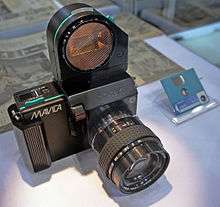Still video camera


A still video camera is a type of electronic camera that takes still images and stores them as single frames of video. They peaked in popularity in the late 1980s and can be seen as the predecessor to the digital camera. The best known models include the Sony Mavica and Canon's Ion and Xapshot cameras.
The most common design has an image sensor and basic processing hardware similar to that of a domestic analog camcorder. However, instead of storing consecutive frames on tape to form a moving image, a single frame is extracted from the output video signal and saved on a rotating magnetic disk (such as a video floppy). In playback, the disk is spun at the frame rate of the video system with the frame being read repeatedly. This produces a conventional video signal that can be viewed on a normal television.
The obvious limitation is that the playback system is roughly equivalent to the operation of a paused video recorder. Since the video is stored as a conventional video frame in a format such as NTSC or PAL, the resolution is limited to that of any other video. And since the images are not stored digitally, transferring the photos to a computer requires a video capture card.
External links
| Wikimedia Commons has media related to Still video cameras. |